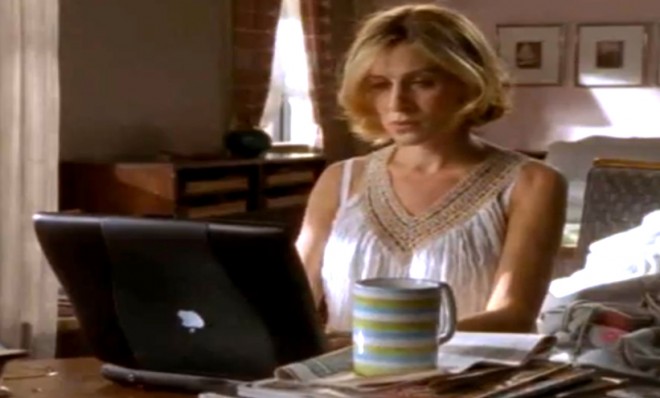Hollywood's utter failure to accurately portray female journalists
We are not plucky brunettes sporting hipster glasses, ready to tussle with old-school editors and sleep with anyone who gets between us and a scoop

Journalism is one of the few jobs Hollywood has always let women do.
Since the start of the talkies all the way through today, "female journalist" has been a classic archetype in film and television. But whereas being a female reporter was once synonymous with tenacity, superior intellect, and wit, today's fictional female reporter serves as shorthand for new media reporter/blogger: young, naïve, and morally bankrupt.
In 1931, Dance, Fools, Dance was released, starring a young Joan Crawford. Crawford played a spunky, educated woman who willfully forgoes the jazzy socialite lifestyle to become a reporter. By the film's end, she not only avenges her brother's death and takes down a murderous gangster played by the devilish Clark Gable — she also gets the guy.
The Week
Escape your echo chamber. Get the facts behind the news, plus analysis from multiple perspectives.

Sign up for The Week's Free Newsletters
From our morning news briefing to a weekly Good News Newsletter, get the best of The Week delivered directly to your inbox.
From our morning news briefing to a weekly Good News Newsletter, get the best of The Week delivered directly to your inbox.
Over the next couple decades, the female reporter was depicted as an agile journalist who shifts easily between "sob sister" stories — ones that captured the emotional angle of a hard-news piece — to a hard-boiled, news hawk investigator. These latter types of female characters happily went toe-to-toe with their male colleagues and wittily, sometimes viciously, buttted heads with their male editors.
We saw these roles from screen legends Barbara Stanwyck, Katherine Hepburn, Bette Davis, and Rosalind Russell. Each, in her turn, developed the character of the work-a-day hack, ambitious scribe, quick-witted investigator and, crucially, the woman underestimated.
These early fictional female reporters were often a bit older, generally unmarried, and sometimes divorced. In 1945's Christmas in Connecticut, for example, Barbara Stanwyck played a food writer who lies to everyone about being married and having children so she can write a column. The column and her career give her fame and the means to remain independent.
These female journalist characters were ambitious, tenacious workaholics who often consciously decide to be childless. Or if our heroine does have a child, the film shows that it was out of wedlock. Sometimes this character adopts a kid (Woman of the Year), other times she pretends a child was hers (Christmas in Connecticut). Still other times, she pretends her own child isn't hers (Forbidden).
A free daily email with the biggest news stories of the day – and the best features from TheWeek.com
In other words, this early archetype embraced human complexity and celebrated ambition.
By the 1960s though — and all the way through the 1990s — the tough, seasoned female reporter besting her male colleagues and bumping up against life's tough choices had faded. (A notable exception: Television's salty, over-40, recovering alcoholic, single mother Murphy Brown, played by Candice Bergen.)
America said goodbye to the hardboiled female journalist. The nation said hello to an adorable young television reporter, magazine writer, or columnist.
This character is cute, single, bubbly, quirky, and naïve. Think Mary Tyler Moore in The Mary Tyler Moore Show, Brooke Shields in Suddenly Susan, and Sarah Jessica Parker in Sex and the City.
Did Sarah Jessica Parker's Carrie Bradshaw ever truly report a story? If she did, we all missed it.
And then came the next sad phase: From the late 1990s through today, the fictional female journalist has once again become ambitious and career driven. She is unmarried and unconcerned with life outside of work. But unlike the fictional female reporters of the 1930s and 1940s, this new archetype is portrayed as ridiculously young and embarrassingly green; so green, in fact, that she resorts to shoe leather reporting as a last resort, not a first.
Eventually for these women, an older male editor/reporter will step in to guide the young lady cub, because this type of fictional female reporter is just a girl. She is clueless, sloppy, and morally bankrupt. Even more, she's always willing to sleep with a source, or an editor, for a story.
With the rise of blogs and hyper-competitive journalism, this recent fictional female reporter has all but usurped the fictional male reporter in popular culture; think Katie Holmes in Thank You For Smoking, Rachel McAdams in State of Play, or Kate Mara in House of Cards.
In Thank You for Smoking, Holmes's Heather Holloway lacks any grasp of journalistic ethics. She dives into a sexual tryst with a nasty lobbyist she's writing about. At one point, she gets all hot and bothered when she sees her lover on television and pants, "I want to fuck you while I watch you on TV."
Unsurprisingly, the lobbyist screws her literally and, later in the film, figuratively.
As far as American pop culture is concerned, the fictional female reporter has become shorthand for the new media climate. Now nearly every time a film calls for a journalist or blogger, in walks a plucky brunette sporting hipster glasses. She's ready to tussle with her old-school editor — and sleep with anyone who gets between her and a scoop!
Back in the real world, however, young underpaid female reporters make up the lowest rungs of most newsrooms. And we rarely see them advance to the top of the newsroom.
Real-life female reporters are a tough group. We are constantly and gingerly navigating the power dynamic intrinsic to the reporter-source relationship, and the mine field of egos back in the newsroom.
In film and television, the young, plucky, morally-bankrupt fictional female blogger isn't struggling against steel-ceiling newsrooms. Neither is she deftly navigating the myriad complex relationships at work and at home.
This disconnect between art and life is not nearly so sharp across the pond. European television and film are introducing viewers to a whole new group of female reporters. For example, Swedish television's Annika Bentzgon: Crime Reporter, starring Malin Crepin, and in the Franco-Polish film Elles, starring Juliette Binoche as Anne.
In both instances, the lead characters are senior reporters who could eat Zoe Barnes for dinner and pick their teeth with the bones of Barnes' copy. These women are older workaholics, struggling with being a wife and mother.
In Annika and Elles, reporters experience what most women and men grapple with in the real world: balancing life and work. Annika and Anne are constantly being derided by their husbands and acquaintances for putting the story and their jobs before their family. Of course, this isn't true. Annika and Anne are shown cooking, cleaning, and picking the children up from school. These women are, however, emotionally guarded. This is something real-life female journalists know all too well.
American popular culture's depiction of the modern female journalist is a sort-of masculine fantasy and scapegoat. The image that is emerging out of Europe is a decidedly grittier version of the female reporter's reality. If only Hollywood could get it right...
Neda Semnani is a freelance writer at work on her first book. She is the former Heard on the Hill columnist and the arts and culture reporter for CQ Roll Call. Her work has also appeared in the Washington City Paper, BuzzFeed, CityStream, and more.
-
 Prickly pear juice recipe
Prickly pear juice recipeThe Week Recommends Jewel-toned, natural juice is a thirst-quenching treat
-
 The truth about vitamin supplements
The truth about vitamin supplementsThe Explainer UK industry worth £559 million but scientific evidence of health benefits is ‘complicated’
-
 Is convenience culture killing community?
Is convenience culture killing community?In The Spotlight A decline in emotional intelligence could be responsible for a diminished sense of belonging